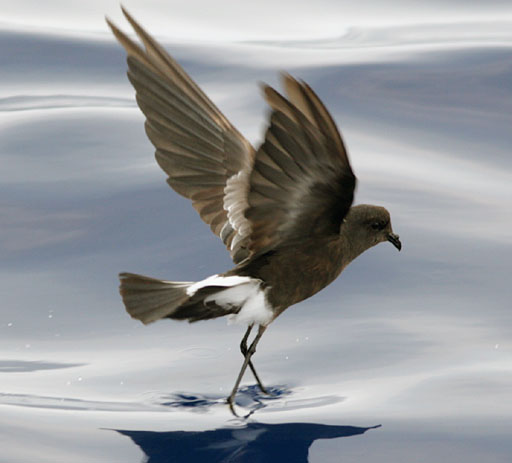|
| Query: European storm-petrel | Result: 6th of 21 | |
Wilson's Storm-petrel (Oceanites oceanicus) - Wiki
| Subject: | Wilson's Storm-petrel (Oceanites oceanicus) - Wiki
| |

| Resolution: 512x463
File Size: 48487 Bytes
Date: 2007:06:23 09:41:05
Camera: Canon EOS 30D (Canon)
F number: f/6.3
Exposure: 1/640 sec
Focal Length: 300/1
Upload Date: 2007:12:13 16:18:51
|
Wilson's Storm-petrel
From Wikipedia, the free encyclopedia
Order: Procellariiformes
Family: Hydrobatidae
[Photo] Wilson's Storm-petrel, Oceanites oceanicus, Location: Gulf Stream off of Hatteras, North Carolina, United States. Date created 2007-06-23. Author Patrick Coin (http://commons.wikimedia.org/wiki/User:Cotinis).
The Wilson's Storm-petrel, Oceanites oceanicus also known as Wilson's Petrel is a small seabird of the storm-petrel family Hydrobatidae. It is one of the most abundant bird species in the world.
The Wilson's Storm-petrel breeds on the Antarctic coastlines and nearby islands such as the South Shetland Islands. It nests in colonies close to the sea in rock crevices or small burrows in soft earth and lays a single white egg. This storm-petrel is strictly nocturnal at the breeding sites to avoid predation by gulls and skuas, and will even avoid coming to land on clear moonlit nights. Like most petrels, its walking ability is limited to a short shuffle to the burrow.
The Wilson's Storm-petrel spends the rest of the year at sea, and moves into the northern oceans in the southern hemisphere's winter. It is much more common in the north Atlantic than the Pacific. It is strictly pelagic outside the breeding season, and this, together with its remote breeding sites, makes Wilson's Petrel a difficult bird to see from land. Only in severe storms might this species be pushed into headlands.
The Wilson's Storm-petrel is common off eastern North America in the northern summer and the seasonal abundance of this bird in suitable European waters has been revealed through pelagic boat trips, most notably in the area of the Isles of Scilly, Great Britain.
The Wilson's Storm-petrel is a small bird, 16-18.5 cm in length with a 38-42 cm wingspan. It is slightly larger than the European Storm-petrel. It is essentially dark brown in all plumages, except for white rump. It differs from the that species by its pale bar on the upper wing, plain underwings and longer legs.
It has a more direct gliding flight than Storm Petrel, but shares the habit of pattering on the water surface as it picks planktonic food items from the ocean surface, though with more upraised wings. Like European Storm-petrel, it is highly gregarious, and will also follow ships. A soft peeping noise is often heard while the birds are feeding.
The name commemorates the Scottish-American ornithologist Alexander Wilson.
Widespread throughout its large range, the Wilson's Storm-petrel is evaluated as Least Concern on the IUCN Red List of Threatened Species.
Trivia
The Wilson's Storm-petrel is the mascot of Oglethorpe University.
http://en.wikipedia.org/wiki/Wilson's_Storm-petrel
| The text in this page is based on the copyrighted Wikipedia article shown in above URL. It is used under the GNU Free Documentation License. You may redistribute it, verbatim or modified, providing that you comply with the terms of the GFDL. |
|
 |

|

|
European storm-petrel
6/21 |

|

|
^o^
Animal Pictures Archive for smart phones
^o^
|
|

